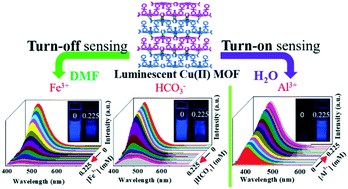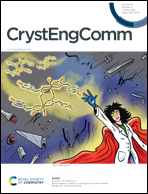Distinct solvent-dependent luminescence sensing property of a newly constructed Cu(ii)–organic framework†
Abstract
A novel luminescent Cu(II)–organic framework, {[Cu(asba)(3bpmo)0.5(H2O)]·H2O}n (1), was obtained through the assembly between copper(II) and 2-amino-5-sulfobenzoic acid (H2asba) in the presence of an auxiliary flexible ligand, N,N′-bis(3-pyridylmethyl)oxalamide (3bpmo). 1 is a 2D (6, 3) topological network, which further extends into a 3D supramolecular network via hydrogen and chalcogen bonds. An indirect bandgap exists in 1. 1 shows high framework stability in common solvents and reversible dehydration–rehydration behaviour. Remarkably, 1 is an especially rare example that exhibits novel solvent-dependent luminescence sensing properties. In DMF, 1 shows selective and sensitive fluorescence “turn-off” sensing of Fe3+ over a number of coexistent metal cations. 1 could also be used as a potential selective and sensitive probe for HCO3− among a variety of interfering anions. Furthermore, 1 shows discriminative sensing of HCO3− over CO32−. In water, 1 shows a quite different fluorescence sensing behaviour from that in DMF. 1 cannot sense Fe3+ and HCO3− in aqueous medium. It is fascinating that 1 shows selective and efficient fluorescence “turn-on” sensing of Al3+ accompanied by a bathochromic shift of the emission peak in water. The limit of detection (LOD) for Al3+ reaches the 0.80 μM (0.02 ppm) level.

- This article is part of the themed collection: Coordination Networks


 Please wait while we load your content...
Please wait while we load your content...